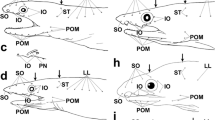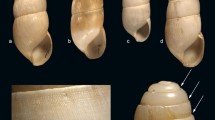Abstract
The fossil scorpionWaeringoscorpio hefteri Størmer, 1970 (Arachnida: Scorpiones) from the Lower Devonian of the Rhenish Massif of Germany is redescribed based on both the original type and newly collected material. A second, more tuberculate species from Siegenian strata near Bürdenbach in the Westerwald (also part of the Rhenish Massif) is described asW. westerwaldensis n. sp. Details of the coxo-sternal region — including the lack of an oral tube — and the number of ventral mesosomal plates are discussed.Waeringoscorpio Størmer, 1970 is best known for its possession of externally-projecting ‘gills’. Our new material reveals that these are indeed pair-wise bundles of rigid, branching filaments which originate laterally, quite possibly from those segments of the mesosoma associated with the book lungs in extant scorpions. Their gross morphology is most consistent with a respiratory organ adapted for use in water. Indeed their closest modern analogues are the tracheal gills of secondarily aquatic insects. We suggest that the morphology and likely palaeoenvironment ofWaeringoscorpio could indicate an aquatic animal, but we draw attention to the uniqueness of its gill-structures, which may not be part of the scorpion ground-pattern. Thus,Waeringoscorpio was perhaps a secondarily aquatic scorpion adapted for benthic life in oxygen-stressed, freshwater-brackish environments.
Kurzfassung
Der fossile SkorpionWaeringoscorpio hefteri Størmer, 1970 (Arachnida: Scorpiones) aus dem Unterdevon (Emsium) des Rheinischen Schiefergebirges wird anhand des Typusmaterials und weiterer Funde neu beschrieben. Eine zweite, stärker tuberkulierte Art aus dem Siegenium von Bürdenbach im Westerwald wird alsW. westerwaldensis n. sp. beschrieben. Details der Coxo-Sternal-Region — ein Mundvorraum ist nicht ausgebildet — und die Anzahl der ventralen, mesosomalen Platten werden diskutiert.Waeringoscorpio Størmer, 1970 ist aufgrund der Ausbildung seitlich abstehender, möglicherweise schlauchartiger Filamente am Mesosoma und ihrer möglichen Funktion als „Kiemen“ von besonderem Interesse. Unser neues Material zeigt, dass es sich bei diesen Strukturen um paarige Bündel steifer, sich distad verzweigender Röhren handelt, die seitlich der mesosomalen Segmente entspringen, welche bei rezenten Skorpionen die Buchlungen tragen. Ihre äußere Anatomie lässt sich am ehesten mit einer Funktion als Atmungsorgan, angepasst an ein aquatisches Milieu, in Einklang bringen. Eine bemerkenswert große morphologische Übereinstimmung zeigen die Tracheenkiemen einiger Larven heutiger, sekundär aquatischer Insekten. Morphologie und der wahrscheinliche Lebensraum vonWaeringoscorpio weisen auf ein wasserlebendes Tier hin. Wir betonen aber die Einzigartigkeit seiner Kiemenanhänge und dass diese nicht unbedingt Teil des Grundmusters der Skorpione waren. Möglicherweise handelte es sich um sekundär aquatische Skorpione, angepasst an eine benthische Lebensweise in einem sauerstoffgestressten Süß- oder Brackwasser-Habitat.
Similar content being viewed by others
References
Becker, G. &Jansen, U. 1998. Solle’s „Hunsrück-Insel“: Eine küstennahe Fauna (Ostracoden, Brachiopoden, Trilobiten) aus Rot-Sedimenten des Ober-Emsium (Unter-Devon) der Moselmulde (Linksrheinisches Schiefergebirge). — Senckenbergiana lethaea77: 195–221.
Braddy, S.J.;Aldridge, R.J.;Gabbott, S.E. &Theron, J.N. 1999. Lamellate book-gills in a late Ordovician eurypterid from the Soom Shale, South Africa: support for a eurypterid-scorpion clade. — Lethaia32: 72–74.
Brauckmann, C. 1987. Neue Arachniden-Funde (Scorpionida, Trigonotarbida) aus dem westdeutschen Unter-Devon. — Geologica et Palaeontologica21: 73–85.
Childress, J.J. &Siebel, B.A. 1998. Life at stable low oxygen levels: adaptations of animals to oceanic oxygen minimum layers. — Journal of Experimental Biology201: 1223–1232.
Delle Cave, L. &Simonetta, A.M. 1991. Early Paleozoic arthropods and problems of arthropod phylogeny; with some notes on taxa of doubtful affinities. — In:Simonetta, A.M. &Conway Morris, S., eds., The early evolution of Metazoa and the significance of problematic taxa: 189–244, Cambridge (University Press).
Dodds, G.S. &Hisaw, F.L. 1924. Ecological studies of aquatic insects. 2. Size of respiratory-organs in relation to environmental conditions. — Ecology5: 262–271.
Dunlop, J.A.;Tetlie, O.E. &Prendini, L. 2008. Reinterpretation of the Silurian scorpionProscorpius osborni (Whitfield): integrating data from Palaeozoic and Recent scorpions. — Palaeontology51: 303–320.
Edney, E.B. 1977. Water balance in land arthropods. — 282 p., Berlin (Springer).
Farley, R. 2001a. Structure, reproduction, and development. — In:Brownell, P. &Polis, G., eds., Scorpion Biology and Research: 13–78, Oxford (University Press).
Farley, R. 2001b. Development of the pectines in embryos ofParuroctonus mesaensis Stahnke, 1957 (Scorpiones: Vaejovidae). — In:Fet, V. &Selden, P.A., eds., Scorpions 2001. In Memoriam Gary A. Polis: 369–381, British Arachnological Society (Burnham Beeches, Bucks).
Fet, V.;Sissom, W.D.;Lowe, G. &Braunwalder, M.E. 2000. Catalog of the scorpions of the world (1758–1998). — 690 p., New York (New York Entomological Society).
Jeram, A.J. 1994a. Scorpions from the Visean of East Kirkton, West Lothian, Scotland, with a revision of the infraorder Mesoscorpionina. — Transactions of the Royal Society of Edinburgh: Earth Sciences84: 238–299.
Jeram, A.J. 1994b. Carboniferous Orthosterni and their relationship to living scorpions. — Palaeontology37: 513–550.
Jeram, A.J. 1998. Phylogeny, classification and evolution of Silurian and Devonian scorpions. — In:Selden, P.A., ed., Proceedings of the 17th European Colloquium of Arachnology, Edinburgh 1997: 17–31.
Jeram, A.J. 2001. Paleontology. — In:Brownell, P. &Polis, G., eds., Scorpion Biology and Research: 370–392, Oxford (University Press).
Kjellesvig-Waering, E.N.K. 1966. Silurian scorpions of New York. — Journal of Paleontology40: 359–375.
Kjellesvig-Waering, E.N.K. 1986. A restudy of the fossil Scorpionida of the world. — Palaeontographica Americana55: 1–287.
Koch, C.L. 1850. Übersicht des Arachnidensystems. — 104 p., Nürnberg (J.L. Lotzbeck).
Lamont, P.A. &Gage, J.D. 2000. Morphological responses of macrobenthic polychaetes to low oxygen on the Oman continental slope, NW Arabian Sea — adaptations of animals to oceanic oxygen minimum layers. — Deep Sea Research Part 2: Topical Studies in Oceanography47: 9–24.
Lehmann, W.M. 1944.Palaeoscorpius devonicus n. g. n. sp., ein Skorpion aus dem rheinischen Unterdevon. — Neues Jahrbuch für Mineralogie, Geologie und Paläontologie Monatshefte (B)1944 (7/9): 177–185.
Manning, P.L. &Dunlop, J.A. 1995. The respiratory organs of eurypterids. — Palaeontology38: 287–297.
Meyer, W. &Stets, J. 1980. Zur Paläogeographie von Unter- und Mitteldevon im westlichen und zentralen Rheinischen Schiefergebirge. — Zeitschrift der Deutschen Geologischen Gesellschaft131: 725–751.
Neagu, A. 2004. Morphology and structure of the tracheal gills of two species of stoneflies (Plecoptera). — Revue Roumaine de Biologie, Biologie animale49: 157–169.
Paläontologischer Arbeitskreis Koblenz 1992. Spuren des Lebens. — 179 p., Koblenz (privately published).
Polis, G.A. 1990. Ecology. — In:Polis, G.A., ed., The Biology of Scorpions: 247–293, Stanford (University Press).
Poschmann, M. &Franke, C. 2006. Arthropods and trace fossils from the Lower Devonian (Emsian) of the West Eifel region/Germany and the Grand Duchy of Luxembourg. — Ferrantia, Travaux scientifiques du Musée National d’Histoire Naturelle de Luxembourg46: 97–115.
Poschmann, M.;Anderson, L.I. &Dunlop, J.A. 2005. Chelicerate arthropods, including the oldest phalangiotarbid arachnid, from the Early Devonian (Siegenian) of the Rhenish Massif, Germany. — Journal of Paleontology79: 110–124.
Remy, P. &Leroy, P. 1933. Presence de Scorpions dans la zone subterrestre du littoral marin. — Bulletin Mensuel de la Société Linnéenne de Lyon12: 39–42.
Rössler, R. 1998. Arachniden-Neufunde im mitteleuropäischen Unterkarbon bis Perm — Beitrag zur Revision der Familie AphantomartidaePetrunkevitch 1945 (Arachnida, Trigonotarbida). — Paläontologische Zeitschrift72: 67–88.
Scholtz, G. &Kamenz, C. 2006. The book lungs of Scorpiones and Tetrapulmonata (Chelicerata, Arachnida): Evidence for homology and a single terrestrialisation event of a common arachnid ancestor. — Zoology109: 2–13.
Scudder, S.H. 1885. Classe Arachnoidea. Spinnen. Skorpione. — In:Zittel, K.A., ed., Handbuch der Palaeontologie, 1. Abt., 2. Band: 732–746, München & Leipzig (R. Oldenbourg).
Seifert, G. 1975. Entomologisches Praktikum, 2nd edition. — 430 p., Stuttgart (Thieme).
Selden, P.A. 1985. Eurypterid respiration. — Philosophical Transactions of the Royal Society of London B309: 219–226.
Selden, P.A. &Dunlop, J.A. 1998. Fossil taxa and relationships of chelicerates. — In:Edgecombe, G.D., ed., Arthropod fossils and phylogeny: 303–331, New York (Columbia University Press).
Selden, P.A. &Jeram, A.J. 1989. Palaeophysiology of terrestrialisation in the Chelicerata. — Transactions of the Royal Society of Edinburgh: Earth Sciences80: 303–310.
Shear, W.A.;Gensel, P.G. &Jeram, A.J. 1996. Fossils of large terrestrial arthropods from the Lower Devonian of Canada. — Nature384: 555–557.
Shultz, J.W. 2007. A phylogenetic analysis of the arachnid orders based on morphological characters. — Zoological Journal of the Linnean Society150: 221–265.
Sissom, W.D. 1990. Systematics, biogeography, and paleontology. — In:Polis, G.A., ed., The Biology of Scorpions: 64–160, Stanford (University Press).
Solle, G. 1970. Die Hunsrück-Insel im oberen Unterdevon. — Notizblatt des Hessischen Landesamtes für Bodenforschung98: 50–80.
Stets, J. &Schäfer, A. 2002. Depositional environments in the Lower Devonian siliciclastics of the Rhenohercynian Basin (Rheinisches Schiefergebirge, W-Germany) — case studies and a model. — Contributions to Sedimentary Geology22: 1–78.
Stockwell, S.A. 1989. Revision of the phylogeny and higher classification of scorpions (Chelicerata). — 413 p., unpublished PhD thesis, Berkely (University of California).
Størmer, L. 1960. A scorpion-like eurypterid from the Lower Devonian of Germany. — Proceedings of the International Paleontological Union; Report of 21. Session, Norden, part22: 87–91.
Størmer, L. 1969. Eurypterids from the Lower Devonian of Willwerath, Eifel. — Senckenbergiana lethaea50: 21–35.
Størmer, L. 1970. Arthropods from the Lower Devonian (Lower Emsian) of Alken an der Mosel, Germany. Part 1: Arachnida. — Senckenbergiana lethaea51: 335–369.
Størmer, L. 1972. Arthropods from the Lower Devonian (Lower Emsian) of Alken an der Mosel, Germany. Part 2: Xiphosura. — Senckenbergiana lethaea53: 1–29.
Størmer, L. 1976. Arthropods from the Lower Devonian (Lower Emsian) of Alken an der Mosel, Germany. Part 5: Myriapoda and additional forms, with general remarks on fauna and problems regarding invasion of land by arthropods. — Senckenbergiana lethaea57: 87–183.
Walliser, O.H. &Michels, D. 1983. Der Ursprung des Rheinischen Schelfs im Devon. — Neues Jahrbuch für Geologie und Paläontologie, Abhandlungen166: 3–18.
Wehrmann, A.;Hertweck, G.;Brocke, R.;Jansen, U.;Königshof, P.;Plodowski, G.;Schindler, E.;Wilde, V.;Blieck, A. &Schultka, S. 2005. Paleoenvironment of an Early Devonian land-sea transition: a case study from the southern margin of the Old Red Continent (Mosel Valley, Germany). — Palaios20: 101–120.
Weygoldt, P. 1998. Evolution and systematics of the Chelicerata. — Experimental & Applied Acarology22: 63–79.
Weygoldt, P. &Paulus, H. 1979. Untersuchungen zur Morphologie, Taxonomie und Phylogenie der Chelicerata. 1. Morphologische Untersuchungen. — Zeitschrift für Zoologische Systematik und Evolutionsforschung17: 85–116.
Wichard, W.;Arens, W. &Eisenbeis, G. 1995. Atlas zur Biologie der Wasserinsekten. — 338 p., Stuttgart (Gustav Fischer).
Wirkner, C.S. &Prendini, L. 2007. Comparative morphology of the hemolymph vascular system in scorpions — A survey using corrosion casting, MicroCT, and 3D-reconstruction. — Journal of Morphology268: 401–413.
Author information
Authors and Affiliations
Corresponding author
Rights and permissions
About this article
Cite this article
Poschmann, M., Dunlop, J.A., Kamenz, C. et al. The Lower Devonian scorpionWaeringoscorpio and the respiratory nature of its filamentous structures, with the description of a new species from the Westerwald area, Germany. Paläontol Z 82, 418–436 (2008). https://doi.org/10.1007/BF03184431
Received:
Accepted:
Issue Date:
DOI: https://doi.org/10.1007/BF03184431




